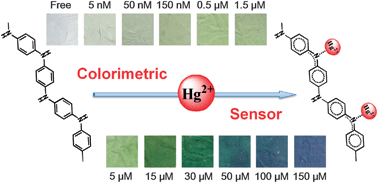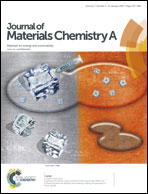Optimized colorimetric sensor strip for mercury(ii) assay using hierarchical nanostructured conjugated polymers†
Abstract
Creating a sensitive and selective method that can provide simple, practical and high-throughput determination of levels of Hg2+ ions in water has proved extremely challenging. This work responds to these challenges by designing, fabricating and evaluating a polyaniline (PANI) based immobilized sensor optimized to exhibit a colorimetric response to trace amount of Hg2+ ions. The sensor design is realized using a leucoemeraldine based PANI as probe, which has a specific interaction with Hg2+ and results in both “off–on” and “color-change” signals. Hierarchical structured nanofibrous sensing membranes within well immobilized probes are fabricated by a bottom-up blending electrospinning nanofabrication method. This sensor shows a vivid colorimetric response specifically to Hg2+ ions (white–yellow/green–green–blue) over other possible interfering metal cations and achieves a low detection limit of 5 nM observed by the naked eye. Additionally, the sensing responses are visualized quantitatively by employing a colorimetric framework that translates measured spectra into numeric color values directly related to color perception. Furthermore, the as-prepared sensors exhibited good reversibility after extended regeneration cycles, which suggests a promising analytical method as an economical alternative to traditional Hg2+ sensors and also provides a new insight into the design and development of a novel colorimetric sensing system based on PANI immobilized materials.


 Please wait while we load your content...
Please wait while we load your content...